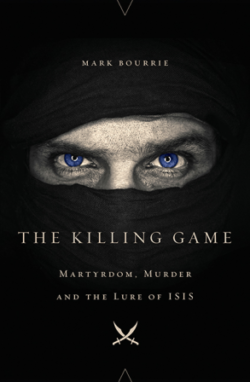Tens of thousands of foreign jihadists have flocked to the Middle East to fight forIslamic State, which also known goes under the name of Islamic State in Iraq and Syria. By all estimates, 60 to 150 of its recruits have been Canadian citizens, a somber fact that emerges in Mark Bourrie’s The Killing Game: Martyrdom, Murder and the Lure of ISIS (HarperCollins).

In his informative and thoughtful book, Bourrie — a Canadian academic and journalist based in Ottawa — takes a hard look at these Canadians and examines IS’ operating procedures.
He focuses on John Maguire, a 23-year-old university dropout from a small Ontario town who regarded himself as “a typical Canadian.”
Maguire was drawn to radical Islam by the online lectures of Anwar al-Awlaki, a U.S.-born Al Qaeda propagandist who was killed in Yemen in 2011 by an American airstrike. At the end of 2012, Maquire left Canada for Syria. In December 2014, he appeared in an IS propaganda video posted on YouTube in which he explained his reasons for joining IS.
He was killed in 2015 during the battle for the town of Kobani. According to Bourrie, 20 percent of Canadian jihadists have ended up dead. “Almost all of the rest are still overseas, leaving their families wondering if they have lost their sons …”

Among the other Canadians mentioned in the book are Farah Shirdon, who was shown in a 2014 IS video burning his passport and threatening Western countries; Hassan El Hajj Hassan, who’s believed to have participated in a bus bombing in Bulgaria that fatally injured Israelis, and Ali Mohammed Dirie, who fought with IS in Syria.
Bourrie also mentions Michael Zehaf-Bibeau, an IS sympathizer who murdered Canadian army reservist Nathan Cirillo as he stood guard at the Tomb of the Unknown Soldier in Ottawa.
In Bourrie’s judgment, Islamic radicalism has become “the most dynamic challenge to Western secularism.” It attracts people who detest Western materialism, suffer from boredom and loneliness and seek adventure.

Islamic State recruits online, in mosques and in prisons. It draws them in because it “has emerged as the most notorious terror group in the world,” he says.
Bourrie points out that IS has exploited social media to the hilt, using it for recruitment and propaganda purposes. When Islamic State launches an offensive, he adds, it informs the world know through Twitter feeds. During its successful attack on Mosul in 2014, IS and its followers sent up to 44,000 tweets a day.
“Social media offers ready-built networks that can connect jihadis to each other, and to potential recruits, free of charge,” he writes.
Bourrie believes that IS can be countered.
Mainstream Muslims can refute IS’ “simplistic and violent interpretation of Islam. This is already happening, but more Muslims have to get involved, and they need the media skills to be able to face IS on the Internet.”
And, of course, “moderate” Muslims need to ensure that their mosques and social groups are neither dominated by nor hijacked by radicals.

Finally, Western nations must create programs that address the needs of young people for jobs, decent housing and the like.
This is sound advice. Islamic fundamentalists can be thrown off-balance and defeated.
